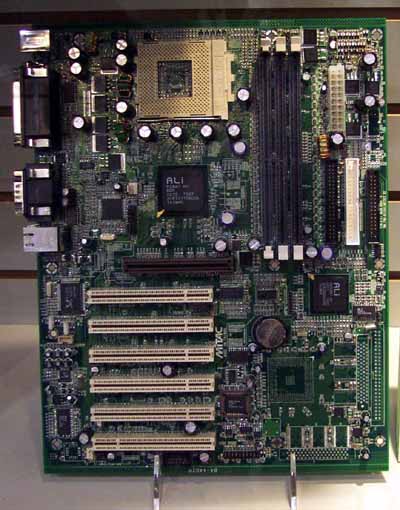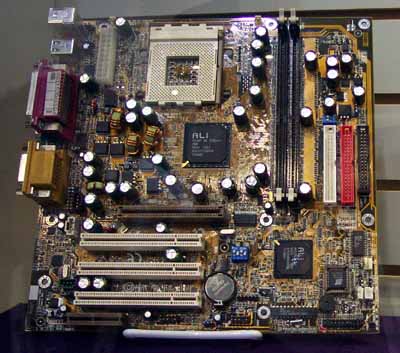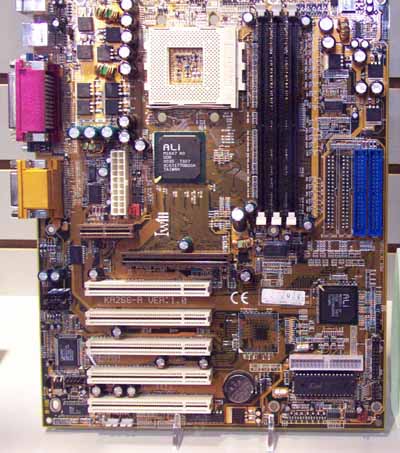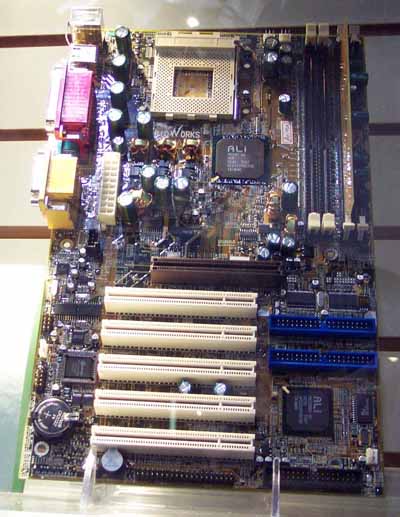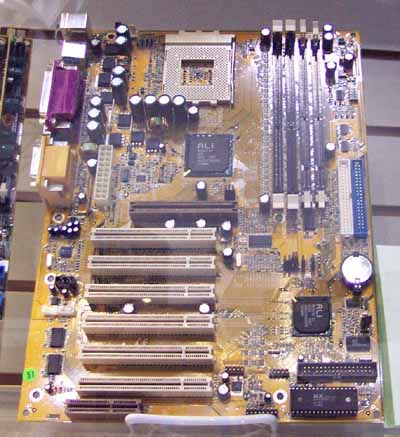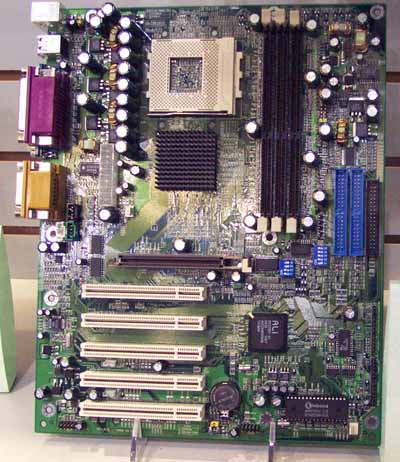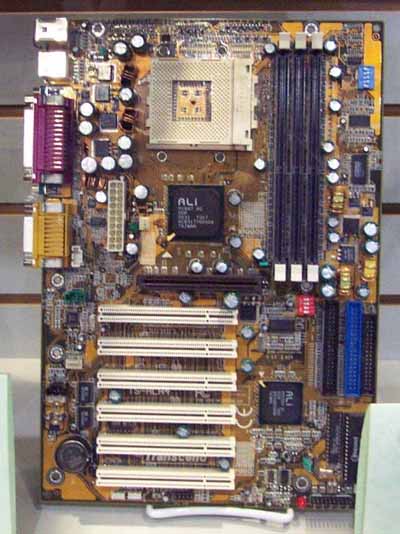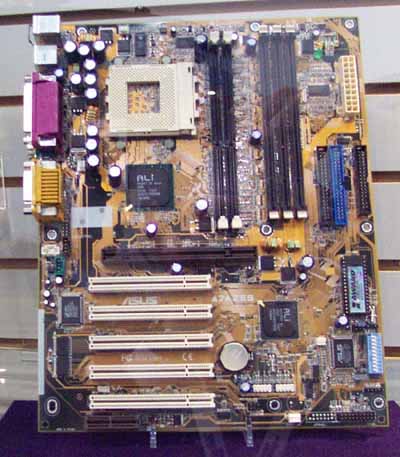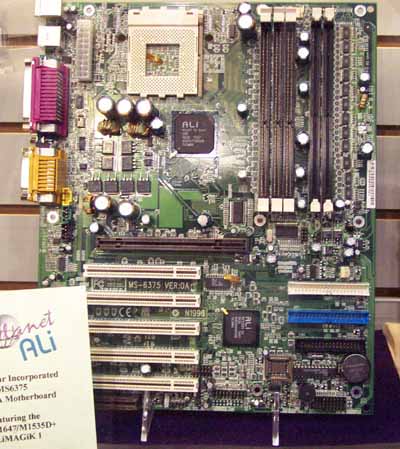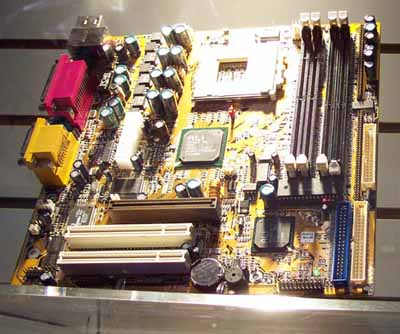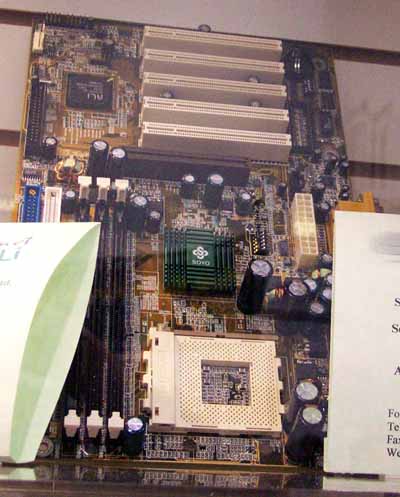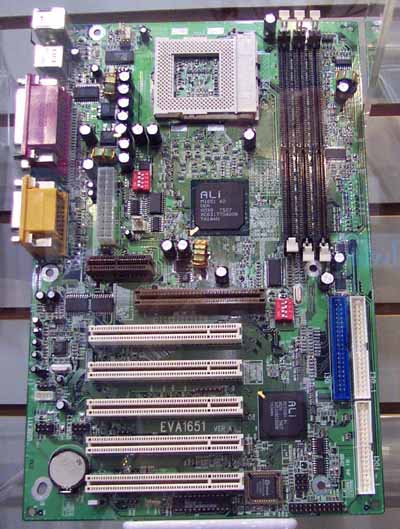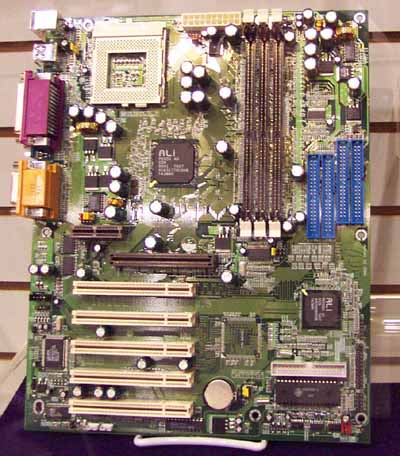
Original Link: https://www.anandtech.com/show/673
ALi has been very quiet for the past year. Between Intel’s 815 and the VIA Apollo Pro 133A covering the Slot-1/Socket-370 end and VIA’s KX/KT133 providing Athlon users with a desirable solution, the ALi we were used to seeing around had all but disappeared. A lot of people have almost forgotten about the existence of ALi, especially newcomers to the hardware enthusiast community. However ALi is definitely working hard at coming back from a disappointing leave of absence from our radars, such is evident by their presence at this year’s Comdex.
At Computex a few months ago we mentioned that ALi had plans to produce DDR solutions for both Intel and AMD processors, with the focus being placed on their AMD solutions at first. As the spotlights this year go to DDR technology, together with the fact that both AMD and VIA are pushing this technology, ALi did make a very good decision. Now with VIA waiting until after the release of their Intel DDR solution before pushing their AMD offering, ALi does have a unique opportunity to step in and scoop up some lost territory.
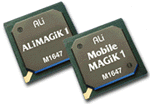 On
the AMD side, ALi released what they called the MAGiK 1 and the MobileMAGiK
1 chipsets. The first one targets the desktop PC motherboard market and the
second one, obviously, targets the mobile PC market. The MAGiK 1 supports all
AMD Athlon processors (100MHz and 133MHz FSB), boasts support for up to 3GB
of SDRAM (either DDR or regular SDR), and of course supports AGP4X as well.
The MobileMAGiK 1 is essentially the same part as the desktop but with AMD PowerNow!
support.
On
the AMD side, ALi released what they called the MAGiK 1 and the MobileMAGiK
1 chipsets. The first one targets the desktop PC motherboard market and the
second one, obviously, targets the mobile PC market. The MAGiK 1 supports all
AMD Athlon processors (100MHz and 133MHz FSB), boasts support for up to 3GB
of SDRAM (either DDR or regular SDR), and of course supports AGP4X as well.
The MobileMAGiK 1 is essentially the same part as the desktop but with AMD PowerNow!
support.
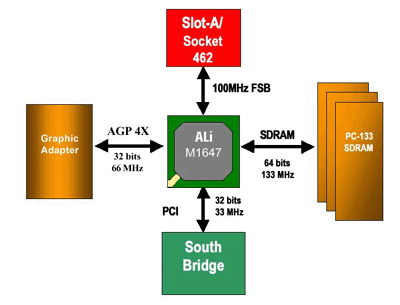
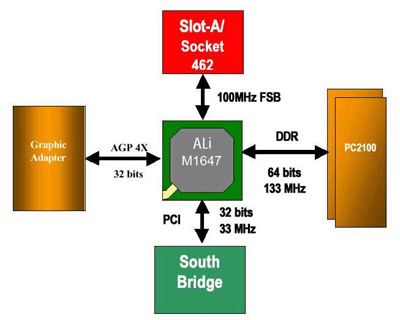
 On
the Intel side of things, ALi has the Aladdin Pro 5 and the Aladdin Pro 5M chipsets.
They support all Slot-1 and Socket-370 Pentium III, Pentium II, and Celeron
processors, up to 3GB of 200/266 DDR memory or PC100 / PC133 SDRAM, and AGP
4X.
On
the Intel side of things, ALi has the Aladdin Pro 5 and the Aladdin Pro 5M chipsets.
They support all Slot-1 and Socket-370 Pentium III, Pentium II, and Celeron
processors, up to 3GB of 200/266 DDR memory or PC100 / PC133 SDRAM, and AGP
4X.
These chipsets will share the same memory, AGP and PCI controllers as the MAGiK 1 series, the only difference being that the Aladdin Pro 5/5M will support Intel’s AGTL+ bus while the MAGiK 1 series supports AMD’s EV6 bus.
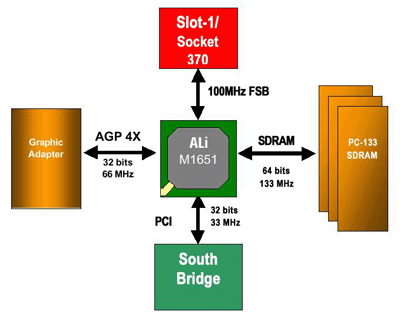
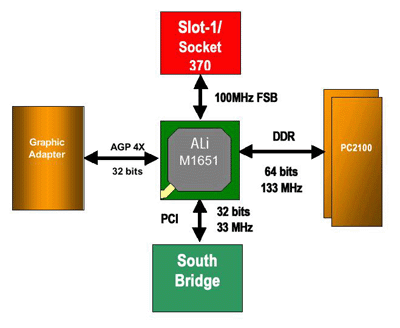
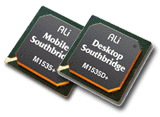 Like
VIA, ALi has a number of pin compatible South Bridge options that provide a
great deal of flexibility. Specifically, manufacturers can use either the M1535,
the M1535D, the M1535+, or the M1535D+ Super Southbridge. They all have an
integrated AC-Link Host controller, Direct Sound 3D, Hardware Sound Blaster
Pro/16 compatibility and now support SPDIF as well. The integrated Host Signal
Processing (HSP) software modem interface eliminates the need for a hardware
modem for reduced system cost. Six USB ports and two USB controllers are integrated
to provided optimum interface for peripheral components. The Super I/O controller
subsystem is also integrated which brings the usual I/O controller functions
including a floppy disc controller, parallel ports, and serial ports.
Like
VIA, ALi has a number of pin compatible South Bridge options that provide a
great deal of flexibility. Specifically, manufacturers can use either the M1535,
the M1535D, the M1535+, or the M1535D+ Super Southbridge. They all have an
integrated AC-Link Host controller, Direct Sound 3D, Hardware Sound Blaster
Pro/16 compatibility and now support SPDIF as well. The integrated Host Signal
Processing (HSP) software modem interface eliminates the need for a hardware
modem for reduced system cost. Six USB ports and two USB controllers are integrated
to provided optimum interface for peripheral components. The Super I/O controller
subsystem is also integrated which brings the usual I/O controller functions
including a floppy disc controller, parallel ports, and serial ports.
The + series of Southbridges basically include all the features as their regular counterparts, but with ATA/100 support. The Southbridges that have a ‘D’ suffix are for desktop implementations, those without the suffix are for mobile usage.
You can expect most newer implementations of the ALi chipsets to use the ‘+’ Southbridges because of their ATA/100 support.
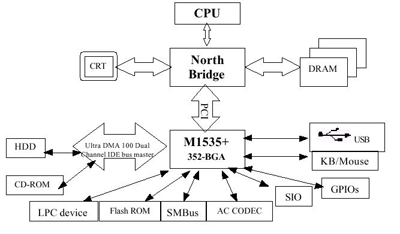

With this complete set of chipset support, ALi attracted a wide range of motherboard manufacturers to adopt ALi chipsets on their motherboard solutions. At the ALi booth, we were able to find a total of sixteen motherboards using the DDR chipsets by ALi. This is a huge improvement from the disappointing display at Computex over the summer.
As far as Socket-462 (Socket-A) motherboards go, we saw boards from: ASUS, Arima Comp, Chaintech, EPoX, Gigabyte, Iwill, MITAC, PC Chips, Soyo, and Transcend. They all used the MAGiK 1 / M1535D+ combination.
This is MITAC, Inc’s 6616AX. Notice the silkscreen area for another chip near the Southbridge as well as the silkscreened connectors near the lower right edge of the picture. It looks like this will be used as a SCSI option which would make the 6616AX the second board that supported the Athlon to boast such a feature. The first being the Microstar K7T Master we reviewed back in September.
This is Gigabyte’s GA-7AM micro-ATX motherboard that uses the MAGiK 1 chipset. Notice the inclusion of no more than 2 DIMM slots. With the traces to the memory banks now required to cope with twice as much data transfer, don’t be surprised to see some full ATX as well as micro-ATX solutions resort to using 2 DIMM slots.
Here we have Iwill’s KA266 which we saw as the only MAGiK 1 based board at Computex 2000 in Taipei. Its layout is extremely similar to that of the KV200-R that we reviewed not too long ago.
Iwill does have another version of the KA266, called the KA266-R, that adds IDE RAID support however with the M1535D+ Southbridge already boasting ATA/100 support there’s very little need for a third party solution unless you absolutely must have RAID support.
The KUAIA from RioWorks.
The A7A266 from Chaintech.
Pay attention to the memory banks, do they look like 4 DDR SDRAM slots? They
shouldn’t, only two are 184-pin DDR SDRAM slots, the other two are 168-pin SDR
SDRAM slots for backwards compatibility. You cannot, however, use the two sets
of banks concurrently.
The EPoX EP-8LKA Socket-A. The dipswitches on the board are indicative of a multiplier control function, overclocking Socket-A CPUs will fortunately be with us for quite some time.
Transcend’s TS-ALR4.
ASUS has always had a strong
relationship with ALi and thus it makes sense that they also use ALi’s MAGiK
1 on their A7A266. The A7A266 is like the Chaintech board in that it supports
both conventional PC100/PC133 SDRAM as well as DDR SDRAM, the only difference
here being that the A7A266 supports three regular SDRAM slots and 2 DDR SDRAM
slots.
Micostar’s MS-6375 also has two sets of 168-pin DIMM slots to allow users keep their old SDRAM.
PC
Chip’s M816, also with the 2 + 2 memory configuration.
Soyo’s K7ACA-R.
For Socket-370 motherboards, AOpen, Iwill, Lucky Star, Maxtium Computer, and Soyo displayed their products.
The EVA 1651 from AOpen.
Iwill’s IA266, again we have the silkscreen present on the board for Iwill’s AMI IDE RAID controller.
Another board from AOpen.
This one is the AP515D2S2 and again we have a 2+2 memory configuration.
The 6AAP5 from Lucky Star Technology Company Ltd.
Final Words
ALi is in a very interesting situation now. If VIA does start producing Pentium 4 chipsets to accent their current line of Athlon products, and if VIA does start focusing more on the Intel market as it seems like by their promotion of the Apollo Pro 266 over the KT266 for an early launch, then ALi could be just what AMD needs to put some pressure on VIA. Remember that AMD is still betting their entire future on the success of these third party chipset manufacturers, so they definitely need full support.
With competition restored to the chipset market things could get very interesting for the consumer. Anyone recall what buying a motherboard in the Socket-7 days was like? With the VIA MVP1, MVP2, MVP3 and MVP4 solutions from VIA up against the ALi and SiS solutions, it was a much more complicated world than it is today. Motherboard manufacturers either had to pick one chipset vendor and stick with them, or more likely, they had to grossly diversify their product lines which isn’t the best solution.
The real question that still exists to this day is, can ALi compete with VIA? We have always ragged on VIA for having poor memory performance but with the experience they’ve gained since the Apollo Pro days, at least the VIA drivers are to the point where they aren’t problematic if properly setup. However ALi has been virtually out of the game for the past year, can they be relied upon to produce not only stable chipsets but solid drivers to accompany them?
While the race to bring DDR SDRAM to the Athlon seems to be heating up, in all actuality the concentration needs to be placed on bringing DDR SDRAM down to the value level which will happen in the coming months. A platform with DDR support and integrated video could make a very happy home for AMD’s next-generation Duron processors. Let’s see if ALi will be the ones to bring that to the table, or will they end up taking a much longer leave of absence after this round in the ring.

